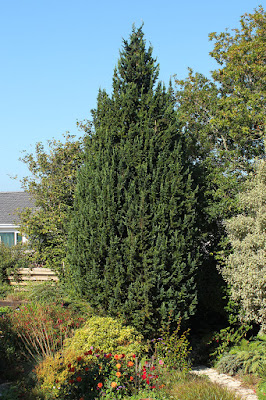Two days ago, to my consternation, I found a shoot on one of the fuchsias in my garden that was clearly infested with gall mite. The whole plant was razed to the ground in minutes and removed to the dustbin taking great care not to touch anything on the way.
Today I went round the garden and scrutinised every fuchsia we have for further signs. I found one infected shoot on a plant perhaps 40 feet away from the first. That plant also was chopped carefully into a plastic bag and binned, the secateurs doused in boiling water.
 |
| Dead centre and far from obvious. |
Sometimes gardening feels like one step forward, two steps back.
OK, I’m down but not out. I’m not giving in and resigning myself to losing all our fuchsias. I intend to fight back. It may be that total eradication proves elusive. It may be that even if it were achieved, new infestations from the same place as this one came from would break out. If I get further outbreaks, I will never know whether their source is plants in my own garden or elsewhere.
I’ve read the entries about gall mite on the websites of the RHS, the British Fuchsia Society, Defra and the American Fuchsia Society. In America, especially California, they have been living with this pest for a lot longer than we have and I think their approach has much to commend it. http://www.americanfuchsiasociety.org/articledirectory/learning-to-live-with-gallmites/#more-286
I will be carrying out careful visual inspections at least fortnightly, preferably more often. Any possible early infestations will go straight into the dustbin. I need to decide on a treatment that can then be applied to the plant that will further suppress the pest and hopefully knock down any that have already moved on from the gall.
The plants I have found infection on now, in late October, have already been cut down to the ground. I need to decide on a treatment for the stumps and surrounding ground. Some kind of winter wash, repeated a couple of times, is what I’m thinking. I won’t destroy those plants, but I will keep an especially close eye on them next year.
It may be that I keep getting outbreaks on the same varieties, in which case I will deem them particularly susceptible and get rid of them. It may equally be the case that some varieties are highly resistant to damage, even to the point of it not being visible, but still support a small population of mites. I think I may cut down all my hardies in autumn (I usually wait till spring) and spray with a winter wash. That way there should be a break of several months when the mites will have nothing much to survive on.
I have a neighbour with a garden half full of fuchsias, some coming through the boundary right where I found the first infestation. I have to grasp the nettle and try to get him to follow the same program. I'm not sure he will be very cooperative.
I'd be massively grateful for any comments on what I'm planning, especially from anybody who has been in the same position.
 |
| Unmistakable and very very unwelcome. |























